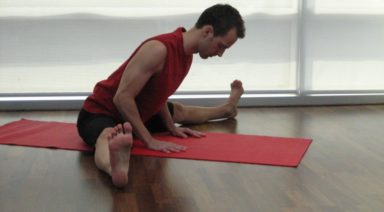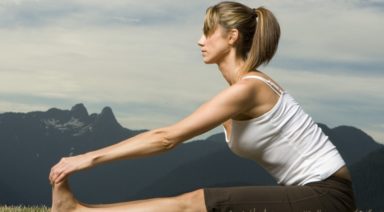Parsva Bakasana: Side Crow Pose

ADJUSTMENTS | BENEFITS | SEQUENCING | SANSKRIT | STEPS | TIPS
Parsva bakasana (PARSH-vah bahk-AHS-anna) is an arm balancing posture requiring a deep twist in the torso. This posture tones the belly and spine. As an arm balance, side crow gives the gift of confidence, balance, and focus.
Philosophy + Origin
Often referred to as the crow pose, bakasana actually translates to crane pose, which may conjure up much more attractive symbolism. Crow pose, or kakasana, is a slightly different pose. In kakasana, the arms are bent; in bakasana, the arms are straight. As the arms straighten into bakasana, the imagery becomes much clearer – the arms long and graceful; the body still and regal. In Asian cultures, especially Japan, the crane represents happiness, eternal youth, good fortune, and longevity. And while the crow is thought to be a harbinger of bad luck or misfortune, in many cultures it symbolizes magic, mystery, intelligence, and destiny.
ADJUSTMENTS/MODIFICATIONS:
- Start with your feet on a block to give your hips a lift.
- Turn your gaze in the direction of your feet to release any fear of falling forward.
- Although you can access this pose more easily by placing your outer hip on your elbow, working to get the hip to hover is a better long-term practice for your shoulders.
STEP-BY-STEP:
- Begin in chair pose with your hands together at heart center. On an exhale, twist to the right by hooking your left elbow as far around your right thigh as possible.
- Slowly lower your hips to your heels, so you are on your tip-toes with the twist.
- Draw your left arm down toward the floor so the armpit is as close as possible to your right thigh. Place the palm of your left hand on the floor just outside your right foot, and your right hand about your shoulder-width distance away.
- Lean your weight into your left arm and slowly shift your weight forward, into your hands.
- Play with lifting your left foot off the ground, then your right. If your feet lift off the ground, keep your feet together and flex your feet (rather than pointing them).
- Hug your belly up and in, and breathe!
- Hold up to 30-seconds or more. When ready, lower the feet down to your mat on an exhalation. Come back to stand at the top of your mat, then repeat on the other side.
PREPARATORY POSES:
- High-to-mid plank | Chaturanga dandasana
- Chair pose | Utkatasana
- Revolved chair pose | Parivrtta utkatasana
SEQUENTIAL POSES:
- Pose of the sage Marchi | Marichyasana I
- Hurdler pose | Eka pada koundinyasana II
- Noose pose | Pasasana
COUNTER POSES:
- Downward-facing dog | Adho mukha svanasana
- Standing forward bend | Uttanasana
- Cow face pose | Gomukhasana
SANSKRIT:
- Parsva = side
- Baka = crane
- Asana = pose
PHYSICAL BENEFITS:
- Strengthens and tones the arms and shoulders
- Engages and strengthens the core.
- Strengthens the hands and wrists
ENERGETIC BENEFITS:
- Focuses mind and energy
- Boosts confidence
Legal Disclaimer Before participating in any exercise program or using any fitness products or services that may be described and/or made accessible in or through the Gaia Website and/or the Services, you should consult with a physician or other healthcare provider. Read more about Gaia’s Terms Of Use.
Hanumanasana: Front Splits Pose

ADJUSTMENTS | BENEFITS | SEQUENCING | SANSKRIT | STEPS
Hanumanasana (hah-new-mahn-AHS-ah-nah) honors the great leap made by Hanuman, the famous monkey god from the Ramayana, across the ocean from India to the mountains of Sri Lanka. Front splits pose demands flexibility, strength, and stability.
Philosophy + Origin
More than just an incredible leap, Hanuman is remembered, celebrated, and worshiped because of his great devotion and courage. To be devoted, one must be bold enough to stand firmly in their beliefs, selflessly serving others and putting others’ needs above their own.
Because of its physical demands, it’s easy to get caught up in “achieving” the outward appearance of the posture. As such, it’s important to keep your ego in check as you dedicate yourself to the posture. Above all, invite kindness and selflessness to flow freely from the posture. As you practice, ask yourself how you can embody Hanuman’s devotion both in your physical yoga practice and your everyday life.





































